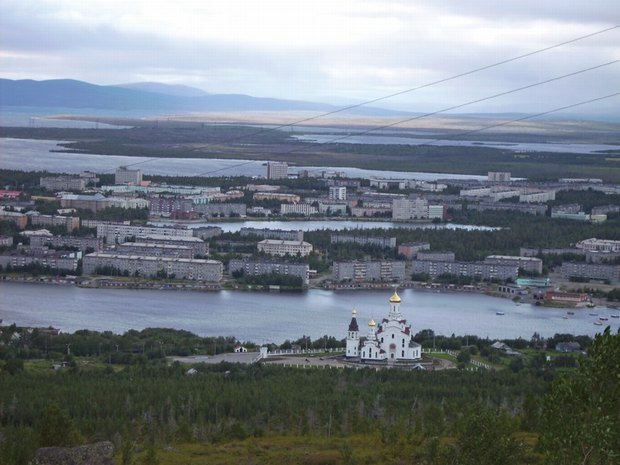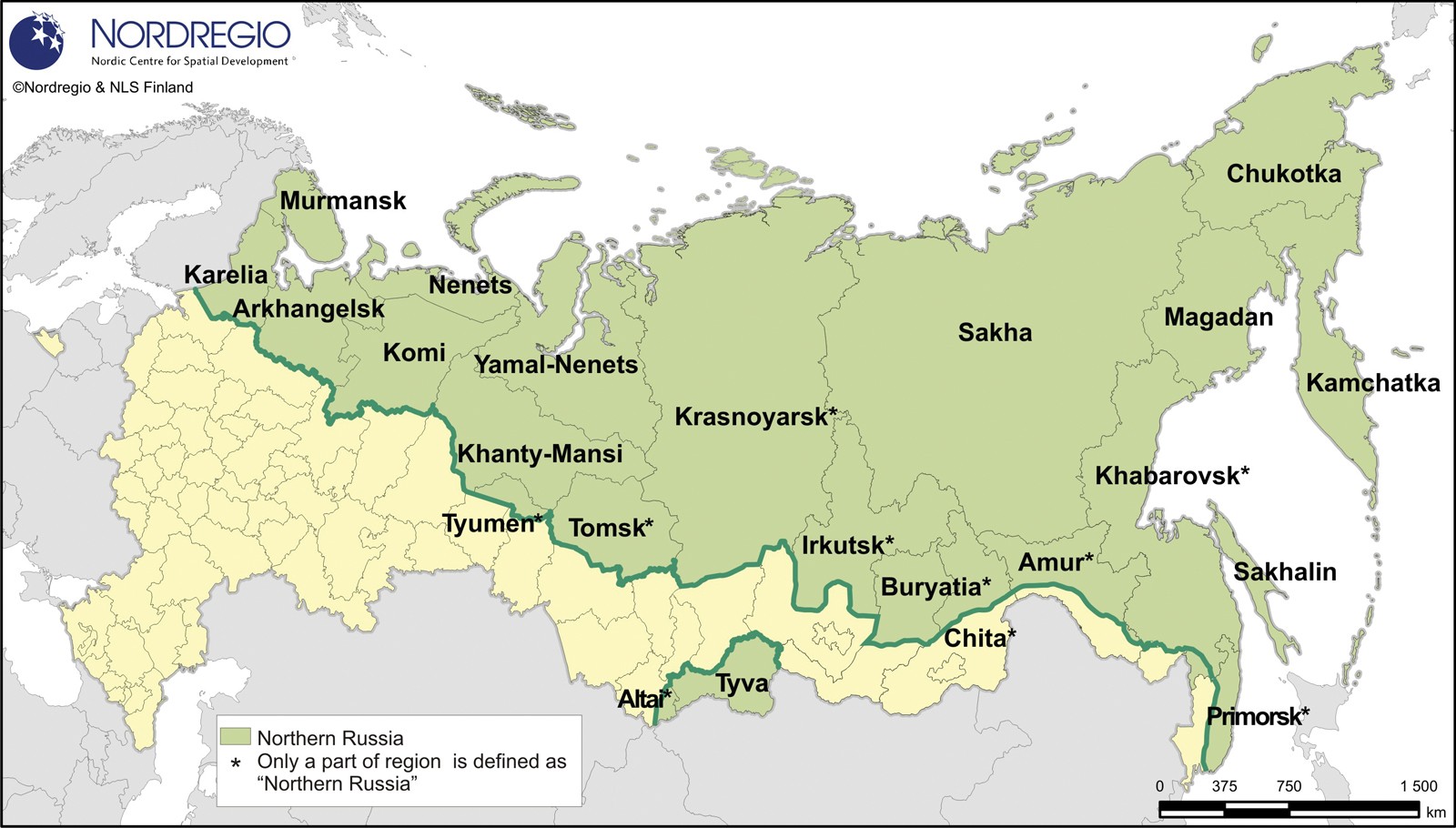
View of the town Monchegorsk. To the left (outside the frame) are the large nickel smelters, responsible for massive pollution of the environment. The town is beautifully located on lake Imandra, while the mining company recently payed for the erection of a church in the traditional Russian style, instead of reducing the outlet of massive amounts of acid fiumes from the smelters. Photo: Rasmus Ole Rasmussen
The Russian definition of which territories are situated 'in the North' is not based on any single, clear-cut criterion. It follows neither climatic nor administrative borders, and the territory covered has thus expanded and contracted according to political trends. Today, however, 11.9 million km2, or about 70 percent of the total territory of the Russian Federation, is defined as belonging to the North. Were it an independent state, the Russian North would thus constitute the world's largest country. The population is, however, modest: currently it stands at 11.5 million, i.e. the population density is less than one person per km2.
The Russian North – a landscape of both tundra and taiga – contains large amounts of untapped natural resources, including most of Russia's oil and gas reserves as well as diamonds, gold, and other valuable minerals. At the same time, it is a constant reminder of the flaws of a planned economy and of the Soviet regime's attempts to defy the logic of the market. Russian authorities today thus face the challenge of developing a new northern policy adapted to the realities of the 21st century.
The Soviet North
Until the 1917 October Revolution, northern Russia and Siberia were poorly integrated into the Russian state and economy and inhabited almost exclusively by indigenous peoples (with the exception of the Arkhangelsk region). A combination of climatic, infrastruc-tural, and technological constraints had prevented Tsarist Russia from developing the riches of the North. The new Soviet authorities, however, envisioned the North as an untapped resource to be exploited for the benefit of the national economy and mythologized it as the 'land of the future'. Under the slogan "the conquest of the North" (osvoenie severa), Soviet authorities set about colonizing this vast realm.
The development of the North required a massive relocation of the workforce. Initially, this was provided by cheap, forced labour from the Gulag – the system of prison camps developed under Stalin. When the Gulag was dismantled after Stalin's death, workers were enticed to move to these often inhospitable tracts by various incentives (higher wages, lower pension age, etc) and a system of labour rotation. Normally, northern workers would, after a set period, return to the South (or 'the mainland' as it was termed in Russian). Not until the 1970s did the Soviets enter the third and final stage of the 'conquest' by attempting to establish a permanent population, which required significant investment in the physical and social infrastructure.
The focus on the extraction of natural resources shaped the settlement structure, not only in the sense that towns were constructed in the immediate vicinity of the resources, but also that the overwhelming majority of these new settlements were 'company towns' set up around a single enterprise. As the settlements developed, it was the company that bore responsibility for developing the entire infrastructure of the settlement in question – from housing to kindergartens and hospitals.
The 1990s: A decade of decline
The Soviet approach to the colonization and exploitation of northern regions had been intimately linked with the logic of the planned economy and its artificial pricing of industrial input and output, especially the gross under-pricing of transportation costs. Thus, it is not surprising that the North was especially hard hit by the introduction of market mechanisms in the early 1990s. It soon became clear that a substantial part of the Soviet settlements had been built up around loss-making enterprises and the future of many northern 'company towns' looked bleak.
While Moscow failed to live up to its obligations and struggled to develop a new future-oriented policy for the North, northerners voted with their feet. With the exception of the main oil- and gas-producing regions in Western Siberia, population levels fell from the Kola Peninsula in the West to the Bering Straits in the East. Hardest hit was Chukotka Autonomous Okrug, the region bordering the Bering Straits and Alaska, which lost almost 70 percent of its population between 1989 and 2002. Half of the federal subjects in the Russian North experienced double-digit losses in the same period.
The out-migration to more southerly parts of the country was welcomed by the government. With a cost of living more than four times higher than the rest of the Russian Federation, it was simply too expensive for the economically weakened state to maintain an adequate social infrastructure throughout the North. But, again, the state underperformed – there were far more people who wanted to leave the North than the state managed to provide for.
The Putin years
As in most other fields of the state administration, the change of presidency from Boris Yeltsin to Vladimir Putin in 1999/2000 also implied fundamental changes in the approach to the North. Indeed, the whole legal-administrative concept of the North came under attack. Various proposals for alternative approaches to calculating northern subsidies were floated, including dividing Russia into six zones of 'discomfort' and assigning each settlement an individual factor. So far, however, the North has survived.
The bureaucratic-administrative bodies however did not. Upon being elected president in spring 2000, Putin closed down the state committee Goskomsever, which had coordinated northern policy during the 1990s. For a while, it survived as a separate department within the Ministry of Economic Development and Trade. However, within a couple of years, this downsized entity was abolished. Northern issues were then transferred to "regular" ministries.
Changes were also introduced in the Russian North itself, most notably as a result of centralization and strong economic performance. Whereas the northern regions in the 1990s had enjoyed substantial autonomy in a decentralized federal system, Putin re-established central control through the introduction of governors as presidential appointees, a ban on regional parties, and limitation of the powers and respon-sibilities of the regional administrations. The centralization trend also resulted in pressure to disband some of the smaller federal subjects in the North. Under Putin, Russia's number of federal subjects has been reduced from 89 to 85 and, by the time he leaves office next year, it will be down to 83. All these mergers took place in the North.
From being on the brink of bankruptcy in 1998, Russia has made a remarkable economic comeback, largely driven by high oil and gas prices. As the Russian North stands for 95 percent of the nation's gas and 75 percent of its oil production, the North has again become a crucial factor in Russian economic development. The income from the energy sector has not only profited the producing regions, but has also given the Russian authorities greater capacity to provide for the more destitute parts of the Russian North. However, the state does not consider it a goal in itself to preserve the current settlement structure and a distinction has been drawn between 'the profitable North' and 'the unprofitable North'. Whereas the former, which includes the settlements built up around profitable natural resource extraction (oil, gas, gold, diamonds, etc) are to be further developed, the latter is to be gradually scaled down.
Towards a revival of the Russian North?
The importance of "the profitable North" for the overall development of the Russian economy is unquestionable: its oil and gas resources will – at least in the short- to mid-term perspective – form the backbone of the economy. Successful exploitation of these resources (including oil and gas resources offshore) will necessarily remain a top priority for the government while the political and economic importance of these resources raises the question of how 'open' or 'closed' the Russian North is to non-Russian actors, most notably foreign petroleum companies. While the development and management of northern resources, in particular oil and gas, is still governed by the desire to achieve market profits, Putin has used these resources to re-position Russia as an influential actor or 'energy superpower' at the international level. Unsurprisingly then, Putin's second term was marked by increased attention to the question of how to promote private investment (both Russian and foreign) in natural resource extraction while maintaining control over natural resource assets that came to be defined as 'strategic'. Regardless, given the importance of northern resources for the Russian economy, the state seems set to play a much more active role in developing the Russian North in the years to come. After a decade of decay, it now appears that the Russian North might be heading for a revival.

According to the current definition, 11.9 million square kilometres, or about 70% of the total territory of the Russian Federation, is defined as belonging to the North. It is important to note that the notion of the 'North' encompasses the actual 'Far North' as well as 'territories equivalent to the regions of the 'Far North'. This emphasis on equivalency make it possible to define as 'northern' some climatically disadvantaged territories in Southern Siberia, even though they are not geographically contiguous with the rest of the North. The present boundaries of the Russian North are demarcated by a heavy green line in the map.
Elana Wilson Rowe Senior Research Fellow and Helge Blakkisrud Head of Section
References:
Blakkisrud, Helge & Geir Hønneland (eds) (2006) Tackling Space: Federal Politics and the Russian North. Lanham, MD: University Press of America. Hill, Fiona & Clifford G. Gaddy (2003) Siberian Curse: How Communist Planners Left Russia out in the Cold. Washington, D.C.: Brookings Institution Press.
Hønneland, Geir & Helge Blakkisrud (eds) (2001) Centre-periphery Relations in Russia: the Case of the Northwestern Regions. Ashgate Aldershot.